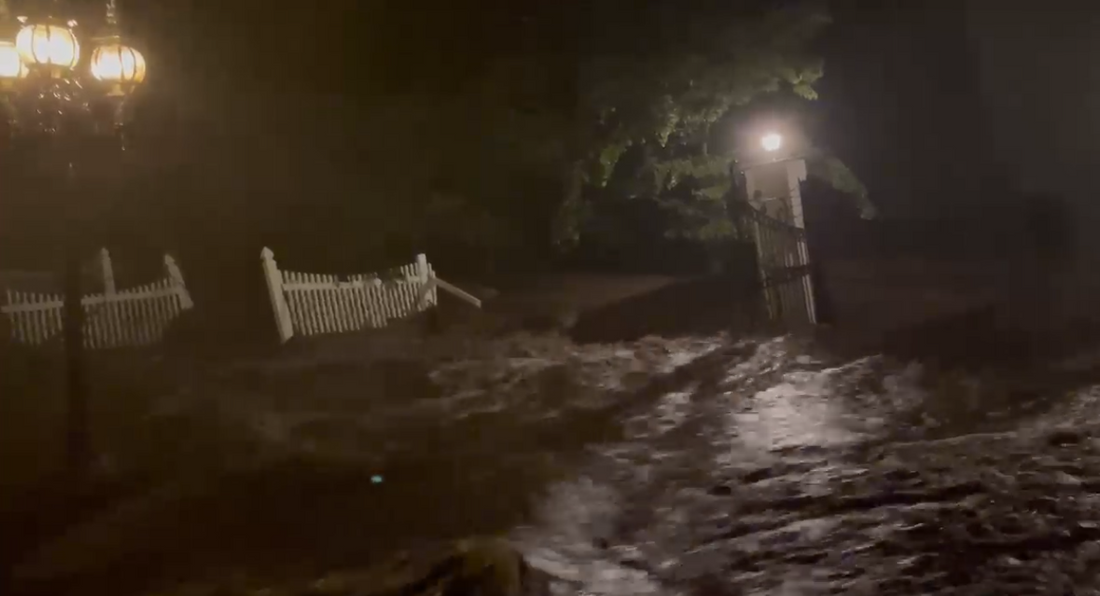In the last few years, Bergen County has seen what feels like an incredible increase in heavy rainstorms. The amount of rain that is falling in these heavy storms is so high, and occurring so quickly that new areas in Bergen County are flooding that have never flooded before.
We had big rainstorms in the past, but now it's becoming a regular occurrence to get more than one inch of rain within twelve hours. These short, violent rainstorms flooded Bergen County in September 2021 with a storm that felt like a part of hurricane season. The September 2021 storm broke multiple bridges around Cresskill, Tenafly, Demarest, and Englewood. The damage lasted for months and the reconstruction efforts took years.

A Cresskill Fire Department truck that became swamped during the September 2021 storm
Next, the violent rainstorms showed up in 2022 as summer monsoons that would drop tremendous amounts of heavy raindrops in violent bursts that turned the residential streets of Alpine into heavy waterfalls.
At the time of this writing, in January 2024, we are expected to get more than two inches of rain between now and sunrise tomorrow.

Wunderground Weather Forecast for January 9, 2024
These rainy conditions wreak havoc on homes and businesses in Bergen County because new areas are flooding that have never flooded before. The heavy winds during these strong rainstorms cause roofs, skylights, and windows to leak, and create even more property damage above ground level. The property damage from each storm is greater than ever, and is continually expanding. One of our clients has owned a commercial building for more than 50 years and it flooded for the first time ever during the September 2021 storm.

J. Campoli & Sons removes damaged carpet and subfloor after flooding.
Why is it flooding so much?
We know the source of this flooding - the increased frequency and volume of rainstorms. The factor that is worsening the effects of the rain, and turning it into massive flooding is the development and infrastructure of Bergen County.

A drainage culvert in Cresskill, NJ that was overwhelmed during a storm and created massive flooding
Bergen County is the most populated county in the most densely populated state in the country. We have a ton of people and buildings crammed into a small space. As that open ground becomes more and more developed, the rainwater has fewer and fewer places to go. That compounds these heavy rainstorms into massive flooding events.
Simply put, as new buildings go up, and existing buildings are expanded, there is less free ground for rainwater to soak into the Earth.

Groundwater and Impervious Coverage
Groundwater conditions are a very important factor when building new construction or additions on homes and commercial buildings. Because this is so important, building department in Bergen County pays close attention to something called impervious coverage.
Impervious coverage is the amount of a building lot that will not allow water to penetrate and soak into the Earth. Typically impervious coverage is created by compacting or covering the ground in that location.

Lot coverage calculations on a survey show the amount of built (impervious) coverage vs. free (pervious) space on a lot
If building lots have too much impervious coverage, they will not allow water to saturate the ground, which will create damaging runoff conditions for the neighboring lots. That is why you can see the max allowable amount of 50% impervious coverage on the calculations above.
Engineers dictate the flow of rainwater and groundwater around new construction so that the buildings will not create flooding conditions. This is a major part of construction design and engineering.

Regardless of how the ground is graded (contoured) or where the drains are placed, as more of Bergen County becomes impervious, water will seek its way to new locations.
What Can Be Done?
Now, we're contractors, so our focus is not on what is causing this much rain - we all know there are changing climate conditions and weather patterns - but rather our focus is on what can be done about all this rain and flooding?
Thankfully, construction makes nearly anything possible. It is possible to create drainage.
On your home or business's building, you can increase the size of your gutters. We always recommend going with a 5" or 6" gutter on your home - whichever will be aesthetically in keeping with the size of your home and roof. Although gutters of any size will be overwhelmed during especially heavy rain storms - the rainwater naturally shears off the roof rather than draining into the gutter - you will be best prepared for all rain conditions with larger gutters.

Splash blocks are dangerous for your property!
Too many times we see homes having their gutters drain out onto their lawns, either on a splash block or just an open leader to the lawn. Not only will this kill your grass and landscaping, this diverts all the rainwater from your roof down right next to your foundation! This is a very dangerous ground condition that will lead to freezing and refreezing conditions for your foundation and will age it quicker than necessary, potentially creating cracks and leaks in your foundation. ALWAYS make sure your gutters drain into a seepage pit! More on seepage pits below.
Inside your home, you can have French drains and/or a sump pump installed by a certified contractor. J. Campoli & Sons have installed many. If your home repeatedly floods, you can have waterproof flooring installed in your basement or locations that do regularly flood, although this is a last ditch effort that soothes the symptom of flooding rather than the problem of flooding itself.
Outside of your building, flooding prevention can be handled by grading the ground to divert water runoff from flooded, puddling areas to areas with drains or more runoff. We also install many seepage pits, also referred to as drywells, drainage pits, storm chambers, or sump pits. (With some variances between the specifications).

Seepage pit installation in Cresskill, NJ by J. Campoli & Sons, Inc.
A seepage pit is created by digging down into the ground, lining the pit with filter fabric, and filling it with stone to create a stone base. A large drywell, the big yellow plastic thing in that photo above, is placed in the pit. The drywell itself is a big inverted plastic trough that creates an open cavity under the ground. Any storm drains in the area are connected to the drywell so they drain into it. You can see the storm chamber drains being routed into the pit below.

Storm chamber being installed in Cresskill, NJ by J. Campoli & Sons
The drywell is then covered with more stone and backfilled with soil.
When the seepage pit is completed, the storm drains catch water and send it to the open space inside the drywell. The water fills up the open cavity in the drywell and can seep out through the stone as fast as the ground conditions will allow.

Yup, the completed seepage pit is below the brand new sod in this photo
Seepage pits are important because they can add a ton of new drainage to areas where there aren't any. They create lots of capacity for storm water underground and allow it to drain out slowly so that flooding is greatly remediated in the area. The ground above the seepage pit will now behave completely differently during a heavy rainstorm, for the better.
So while these flooding conditions in Bergen County are a new and worsening situation, fortunately there are ways that a competent contractor can help prevent future damage to your home and business. If you need any help with rainwater or groundwater conditions at your home or business, book a preconstruction consultation with us.

